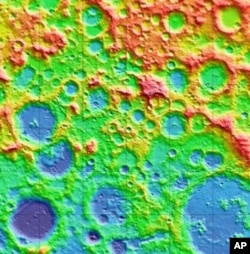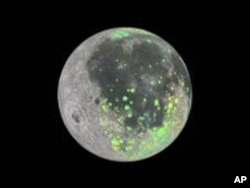Images from a NASA probe have allowed scientists to create a precise map of the moon.
Since its launch to the Moon more than a year ago to survey future manned and robotic landing sites, the U.S. space agency's Lunar Reconnaissance Orbiter, or LRO, has beamed back a trove of high-quality images and other data about Earth's nearest neighbor.
LRO has revealed detailed images far different from the ones Brown University geology professor Jim Head used when he worked in the Apollo program, which sent the first men to the moon in 1968. Brown says the lunar maps back then were based on images with lower resolution and limited viewing angles, which meant that deciding where astronauts could land involved a fair amount of guesswork.
"But what we have here with the LOLA instrument is the ability to create maps that actually look like images. So we have over 2.5 billion shots of laser data which we've combined together to create these global topographic maps and they give us an even portrayal of the topography, largely composed of impact craters over the whole surface of the moon."
The "LOLA" instrument Head refers to - the Lunar Orbiter Laser Altimeter - counted some 50,000 craters in one 20-kilometer area. Chief lunar scientist Mike Wargo says the new maps can pinpoint safe landing sites, but also provide details about, for example, how that landing site is lit by the sun.
"And by understanding the topography and the position of that topography with respect to the sun, we can identify those areas that have very nearly 100 percent continuous illumination so that we have the availability of long-term solar power available for future robotic and human explorers."
The new topographical data shows a more complex moon than previously thought, one bombarded by two distinct populations of asteroids or comets in its turbulent early history. The record of those ancient bombardments, which also pummeled the young Earth, is preserved in the moon's heavily cratered surface.
Brown geology professor Jim Head notes that most of the Earth's impact craters have been eroded away by wind and water or seismic shifts. So the lunar landscape, Head says, offers a unique platform on which to study how our planet and our solar system evolved.
"It's an exciting time to get at these things and it's unlocked a whole series of new missions and goals and objectives that we can accomplish by using the moon as essentially this Rosetta stone of the understanding of the early solar system."
In addition to spectacular images, LRO instruments have measured lunar temperature and radiation levels, helped confirm the presence of hydrogen and oxygen in lunar ice and gathered new information about the composition of the moon's rugged surface.
LRO will continue in lunar orbit for another two to four years. Three papers examining the orbiter's data are published this week in the journal Science.















